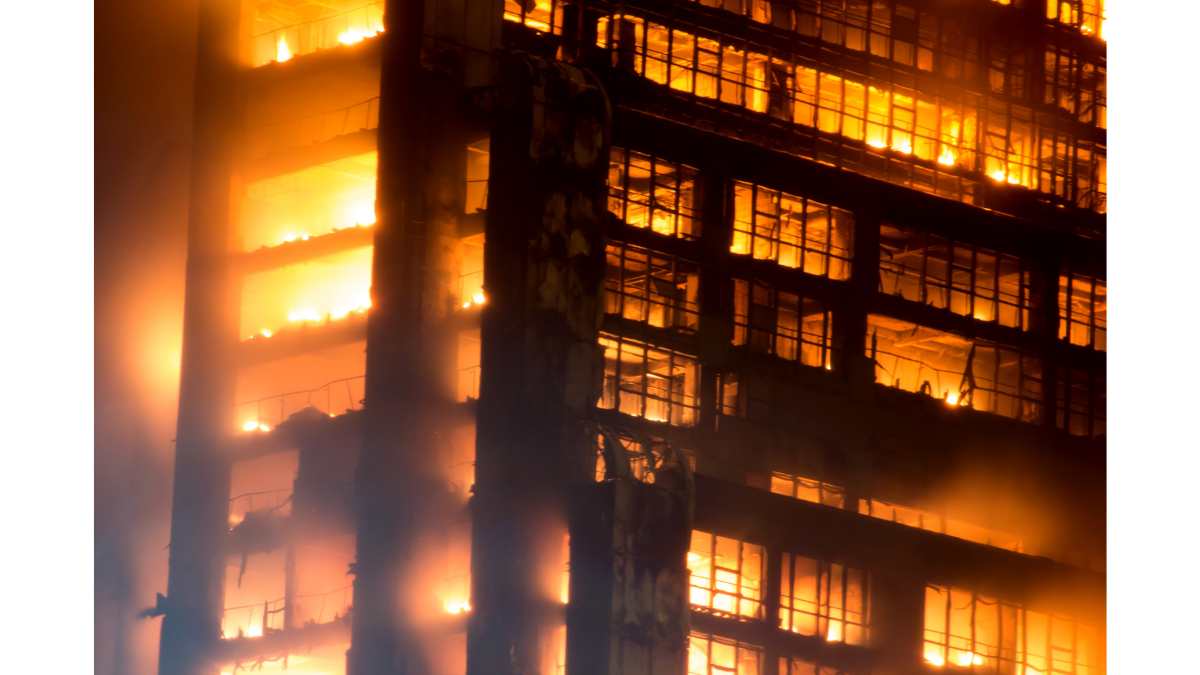On this occasion, our columnist makes a comparative analysis between the applicable standards when testing structures and construction materials.
by Jaime A. Moncada, PE*
A year ago, in this magazine, I introduced the concept of fire resistance, a topic that is relatively new in most Latin American countries.
Fire resistance refers to the ability of a material or structure to withstand exposure to the high temperatures of a fire, without losing its structural integrity or becoming a safety hazard to building occupants or firefighters trying to control the fire. Fire-resistant (RF) materials are also designed to slow the spread of flames. Fire resistance is usually measured in terms of time, in hours or minutes, although this does not necessarily denote how long a material could withstand an actual fire before it fails or loses its effectiveness.
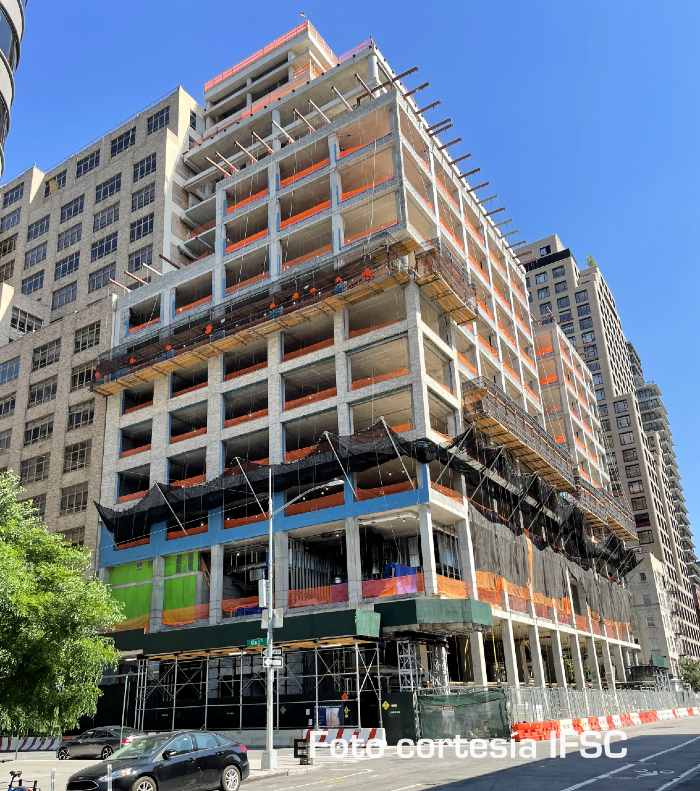
Construction methods and their fire resistance in high-rise buildings are very similar globally.
Building Codes
In those countries where a modern building code exists, these codes, in addition to requiring fire protection systems and means of evacuation, establish minimum RF requirements to help maintain structural integrity. Both the International Building Code (IBC) and the Building and Safety Code (NFPA 5000) define the types of construction of buildings, based on a certification of the fire resistance of structural elements. This RF refers to the time, in minutes or hours, that materials have withstood fire exposure in a test furnace, under a Normalized Time-Temperature Curve, which is not necessarily equivalent to what occurs in modern fires. This curve will be explained in more detail later.
The fire resistance of the construction elements is evaluated under three main criteria or parameters:
1. Maintain structural integrity, stability, or ability to withstand a load despite fire exposure. In other words, avoid collapse during the fire.
2. Provide a physical barrier to restrict the spread of the fire and prevent the passage of flames.
3. Provide thermal insulation in such a way that thermal transmission is limited so that ignition of the unexposed surface, or of any material located in the vicinity of that surface, does not occur.
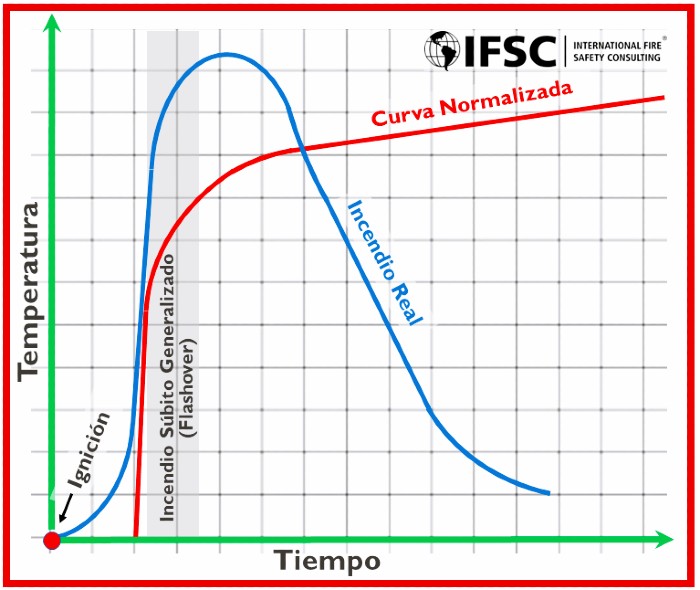
Modern fires tend to have higher temperatures, but also to extinguish more quickly than what is represented in the normalized Time-Temperature curve.
Nowadays the RF that a building should have is established through an evaluation of its built area, number of floors, height, percentage of façade and distance from other buildings, depending on its occupancy. That is, a building with a riskier occupancy, for example a hospital, with a given building area, number of floors, and height, must be constructed with a structure that has a higher fire resistance than that of an identical building with a less complex occupancy, such as a merchant store.
The IBC or NFPA 5000 explains this in greater detail. Depending on the document, these codes establish 9 to 10 different types of construction for buildings. In the NFPA standard, these types of construction are defined in NFPA 220, Standard on Building Construction Types.
Normalized Time-Temperature Curve
The universally recognized way to establish the RF of a construction element is through a fire resistance test in a furnace, such as the one shown in the attached photo. In this sense, the RF of beams, columns, doors, wall sections, penetration protections and joints, etc., is determined by their performance in this furnace when it is heated following the Normalized Time-Temperature Curve.
The first fire protection engineering concepts that tried to quantify the severity of fires were about the impact they had on the structural stability of buildings. One of the first tests of RF elements was carried out at an architects' club in London in 1790(2). But it wasn't until a century later (after the Great Baltimore Fire of 1904, which was started by the collapse during the fire in a 10-story building) that Columbia University in New York began to study how to test a building's fire resistance. This is how the Normalized Time-Temperature Curve, which today is used almost identically worldwide, was devised.
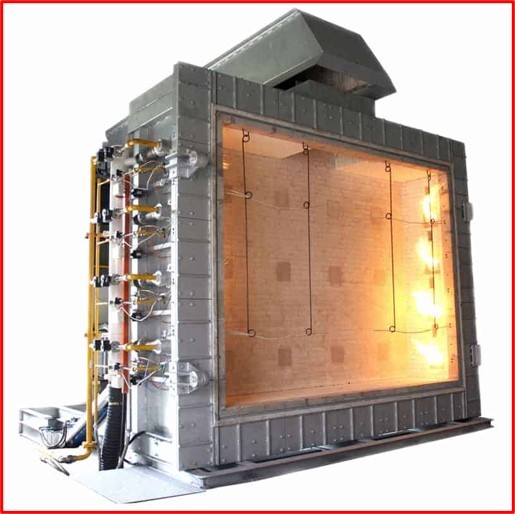 Fire resistance testing furnace for construction elements.
Fire resistance testing furnace for construction elements.
This time-temperature curve has been defined more than 100 years ago in ASTM E119, Standard Test Methods for Fire Resistance Testing of Buildings and Building Materials. The old NFPA 251, a standard with the same content as ASTM E119, but which was retired by NFPA in 2010, also defined an identical curve.
International Regulations
In Latin America, we follow the NFPA regulations in almost all countries. However, it is also common for some construction projects to require specifications based on ISO standards or European Codes (or European equipment is imported to our local markets and we wonder if it meets the requirements of NFPA). So it's reasonable to ask what the difference is between these international standards and NFPA standards.
The good news is that international standards, led by ISO 834, Fire Resistance Tests – Construction Elements in Buildings, use a Time-Temperature Curve quite similar to that required by NFPA, which purposely uses ASTM E119 as a reference for this topic. This means that construction specimens that are tested in a test furnace in most of the modern world, to establish their RF, are analyzed under basically the same temperature.
It has been found that in RF tests of shorter duration, perhaps up to 90 minutes, the ASTM E119 test is slightly more severe than the test under the ISO 834 curve. In longer tests (≥ 90 minutes), the severity of the test under ISO 834 is slightly higher. The figure below, taken from a course on fire resistance that I teach, compares different time-temperature curves in international use.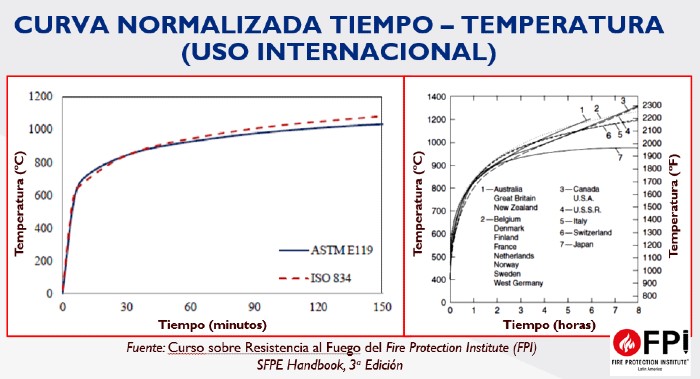
Differences Between European and NFPA-Required Tests
As already established, the time-temperature curves used in Europe are similar to those used in the NFPA standard, which as I mentioned requires compliance with ASTM E119. European regulations are extensive on the subject of structural strength and establishing a point-by-point comparison between European requirements and those found in NFPA would be almost impossible. But, in my opinion, if a door or wall with similar RF is certified either in Europe or in the United States or Canada, my tendency is to approve it.
Testing under ASTM E119 requires a hose test to ensure that the construction element is able to withstand the abuse of a high-pressure fire suppression hose, which I find very practical. Europeans do not require this test. What does seem to me to be far-fetched and without any technical justification is what some European importers in South America have suggested: allowing only European certifications and eliminating those based on ASTM E119.
To give an example, a Latin American fire panel manufacturer hired us with the aim of comparing the European standard for non-load-bearing fire walls (BS EN 1364-1, Fire Resistance Tests for Non-Load-Bearing Elements. Part 1: Walls) with ASTM E119. By the way, BS EN 1364-1 uses the time-temperature curve specified in ISO 834. As you can see in the table below, there are differences, but these are not important.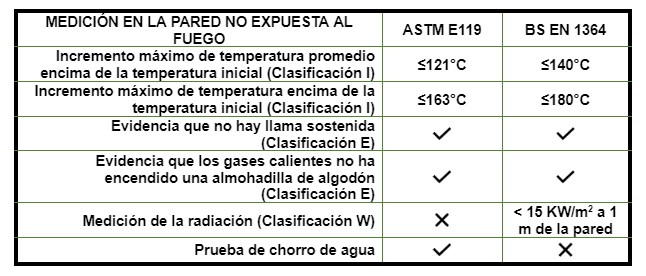
Differences Between RF Tabulation
Typically, RF testing is designed for building elements whose fire resistance is usually determined in terms of "RF" of 20 min, 30 min, 45 min, 1 hour, 1-1/2 hours, 2 hours, 3 hours, and 4 hours. Perhaps one of the main differences between European standards and NFPA/IBC is in how the RF classification is expressed. Fire resistance in the NFPA/IBC standard is typically expressed in hours, except for RF elements less than 1 hour, when expressed in minutes.
The European standard uses fire resistances that are expressed in minutes, but additionally independently indicate Integrity (E), Thermal Insulation (I) and Radiation Control (W). These RF classes can be better understood in the graph below.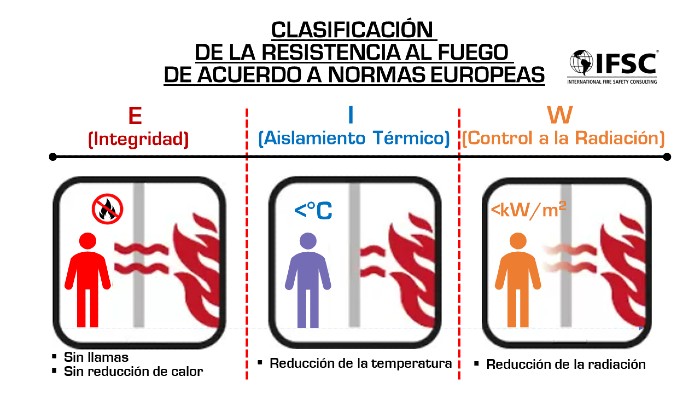
How RF is set
Typically this is achieved through testing in fire resistance testing laboratories. These tests are performed by an independent laboratory, with Underwriters Laboratories (UL) being the most well-known testing laboratory. Factory Mutual has also recently started conducting these tests. There are dozens of testing laboratories in Europe.
In Latin America, there are four testing laboratories: IPT in Brazil, INTI in Argentina and two in Chile: IDIEM and DICTUC. However, I must emphasise that it is not valid for the manufacturer of the construction element to certify its own product, since such certification should be determined independently by one of these testing laboratories.
However, for certain standardized elements such as concrete, brick, drywall, wood, and metal structures with fire-resistant coatings, their strength can be calculated using accepted empirical methods. In this case, a fire protection engineering firm should evaluate the structural element and give its technical assessment on the equivalent fire resistance. The most commonly used standard for this purpose is ASCE/SEI/SFPE 29 (3). On the other hand, the Society of Fire Protection Engineers (SFPE) has recently published a manual that documents our understanding to date of structural performance in the event of a fire (4).
As a final comment, I would like to recommend the area where fire inspectors should focus their attention, as it is where, in my experience, there are the most problems in buildings in our region. This is the certification of doors, openings, penetrations and joints. These elements must be certified by an independent testing laboratory and must be installed in accordance with the manufacturer's recommendations, as there is no empirical calculation method for this type of construction elements.
Footer:
1. Introduction to Fire Resistance, Moncada, J.A., Safety Sales, Vol. 26, No. 6, pp. 59-59.
2. The History of Fire Protection Engineering, NFPA-SFPE, Richardson, J.K., page 8.
3. Standard Calculation Methods for Structural Fire Protection, by the Structural Engineering Institute, American Society of Civil Engineers and the Society of Fire Protection Engineers, 2005.
4. International Handbook of Structural Fire Engineering, LaMalba, K, Hopkin, D, Editors, Society of Fire Protection Engineers, 2021.
 Jaime A. Moncada, PE is a principal at International Fire Safety Consulting (IFSC), a Washington, D.C.-based fire protection engineering consulting firm. and with offices in Latin America. He is a fire protection engineer graduated from the University of Maryland, co-editor of the NFPA Fire Protection Handbook, former vice president of the Society of Fire Protection Engineers (SFPE), who for 15 years led NFPA's professional development programs in Latin America. Mr. Moncada's email address is [email protected].
Jaime A. Moncada, PE is a principal at International Fire Safety Consulting (IFSC), a Washington, D.C.-based fire protection engineering consulting firm. and with offices in Latin America. He is a fire protection engineer graduated from the University of Maryland, co-editor of the NFPA Fire Protection Handbook, former vice president of the Society of Fire Protection Engineers (SFPE), who for 15 years led NFPA's professional development programs in Latin America. Mr. Moncada's email address is [email protected].


